Colorful vegetables are a fantastic way to add interest and beauty to your garden. Every year, I strive to make my veggie plot look just as vibrant and pretty as my flower beds, and you can too.
So in this post, I’ve put together a list of my favorite and most fun crops so you can plant a wide variety of hues, and eat the rainbow.
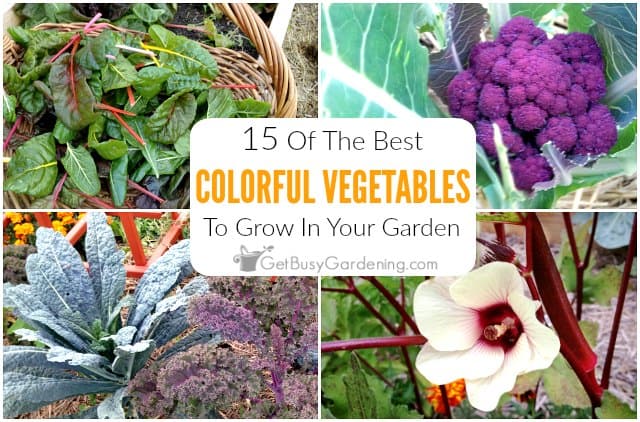
What Vegetables Come In Different Colors?
Most new gardeners don’t know this, but many heirloom varieties of the basic vegetables come in different colors.
A few of my favorites are Kaleidoscope carrots, purple cauliflower, yellow beans, white radishes and rainbow corn have been around for a long time. Below I’ve included even more unique options for you to choose from.
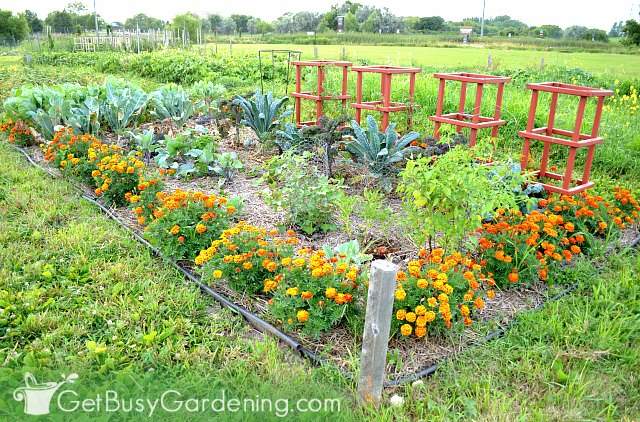
List Of Colorful Vegetables To Grow
Almost any veggie that you want to grow comes in a non-traditional hue. But to get you started, here are some of my favorites…
1. Purple Vegetables
I’ll start the list off with some very common purple vegetables. A few of the most popular are cauliflower, peas, broccoli, Brussels sprouts, carrots, sweet potatoes, cabbage, and tomatillo. These are especially popular with the kiddos.
2. Radishes
Though traditional radishes add bright pops of red to the garden, they come in a mix of other hues too.
From white to yellow, pink, orange, purple, dark red, and even black – so you have a ton of options to choose from here.
3. Swiss Chard
Chard is not only delicious and easy to grow in just about any vegetable garden, it’s also very colorful – red, orange, yellow, pink, and even white.
Some varieties are so bright they’re almost neon, like my favorite the Bright Lights mix – this is definitely a must.
4. Herbs
Though not technically a vegetable, herbs come in tons of different colors that you can add to the garden.
Purple basil, yellow marjoram, tricolor sage, white sage, red mustard, chartreuse mint, and variegated herbs are all excellent options.
5. Lettuce
Another simple one to incorporate, lettuce is the perfect addition to any garden. It comes in a wonderful mix of sizes, colors, and textures, which add even more interest to your veggie garden.
If you’re looking for the reds and pinks, Valentine Mesclun, red leaf French Redina and Romaine Rouge D’Hiver are great.
6. Peppers
I’m sure you’re familiar with green, red, and yellow bell peppers, but did you know they also come in an array of other hues?
There are tons of other types of peppers too, not just bell, and they come in just about any color imaginable. Even black and variegated options. Learn how to grow peppers here.
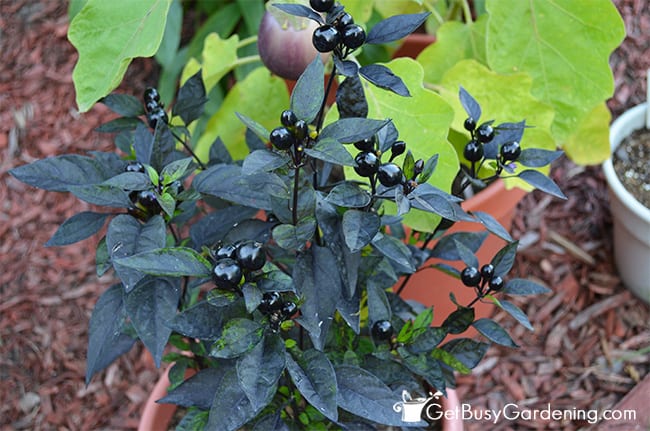
7. Beets
Not only are they delicious, beets are gorgeous too. They come in a wide range of colors, from orange, to white, yellow, and dark red… you name it.
8. Beans
Whether you choose bush varieties or climbers, beans are a staple in most vegetable gardens, and they can be very colorful.
Trade in your boring green beans for the more interesting varieties, like yellow and purple, or maybe even some multi-colored ones. How fun! Learn all about how to grow green beans here.
9. Kohlrabi
If you’ve never tried kohlrabi before, I highly recommend it. It’s yummy and easy to grow, plus it’s really pretty. Purple kohlrabi is very bright, and has beautiful stems and leaves too.
10. Carrots
There’s no denying that traditional bright orange carrots really stand out in the garden. But did you know that they come in a rainbow of varieties?
Surprise your party guests this summer by serving red, yellow, white and purple carrots on your veggie tray. Trust me, it’s a big hit.
11. Radicchio
Though it’s not the most common veggie out there, radicchio is a great choice for adding color to your plot.
It’s easy to grow, and quick to harvest too, which means you can make room for even more crops later on.
12. Okra
The thing I love the most about okra is that it’s a double winner. Not only are the plants very prolific producers, they also have gorgeous flowers.
Red burgundy has dark colored stems, flowers, and fruits. But don’t discount the green okra, because it also has very pretty flowers.
13. Squash and gourds
If you love growing gourds and squash in your vegetable garden, you’ll have a ton of colorful options to choose from.
A few of my favorites are yellow zucchini, butternut, delicata, yellow or white pattypan, multi-colored acorn squash, and funky gourds.
14. Onions
I’m sure you’re familiar with yellow onions, as well as white and red. But there are other options you can try too.
Toss in a mix of red shallots, scallions, and yellow or Red Cipollinis for an even more exciting mix. Learn how to grow onions here.
15. Kale
This is one of my absolute favorites, and kale is so pretty. Plus it does equally well in cold or hot weather, so it’ll add gorgeous contrast from spring through fall.
Kale comes in a variety of colors and textures, you can’t really go wrong. Be sure to mix some Blue Lacinato with frilly purple and also Red Winter, my favorite combos.

Your veggie garden doesn’t have to be purely functional, it can be colorful too. So use this list to plant a rainbow of hues in your plot this year, and have some fun with it.
Up next: Growing Vegetables: The Ultimate Vegetable Garden Guide
If you’d like to learn how to make the most of your space and get as much homegrown food as possible, then my Vertical Vegetables book is perfect! It will teach you all you need to know, has tons of gorgeous photos, and includes 23 DIY projects you can build for your own garden. Order your copy today!
Learn more about my Vertical Vegetables book here.
More About Vegetable Gardening
- 17 Easy Vegetables To Grow In Your Garden
- 15 Fast Growing Vegetables To Plant In Your Garden
- 40+ Vegetables That Grow In Shade
- How To Decide What To Plant In A Vegetable Garden
Share your favorite colorful vegetables in the comments below.
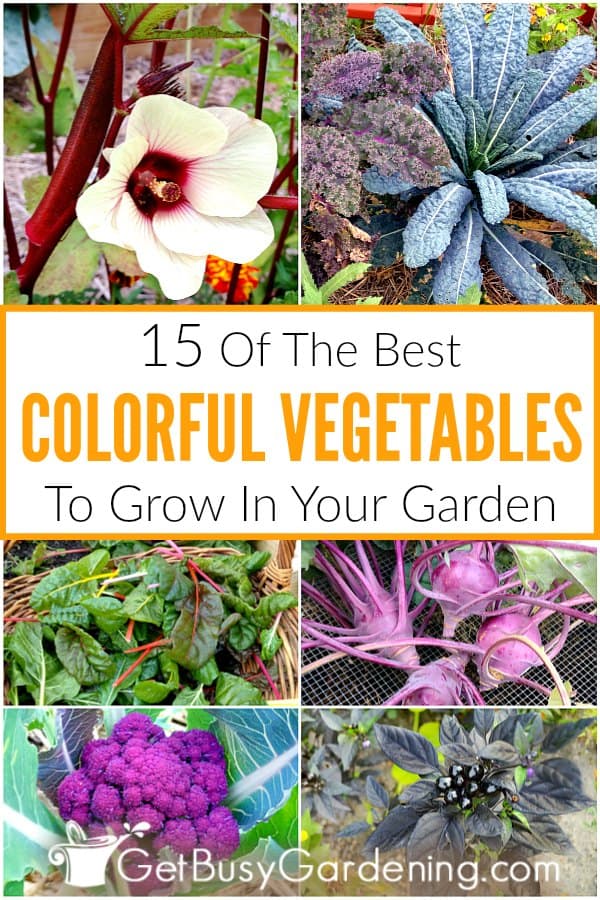

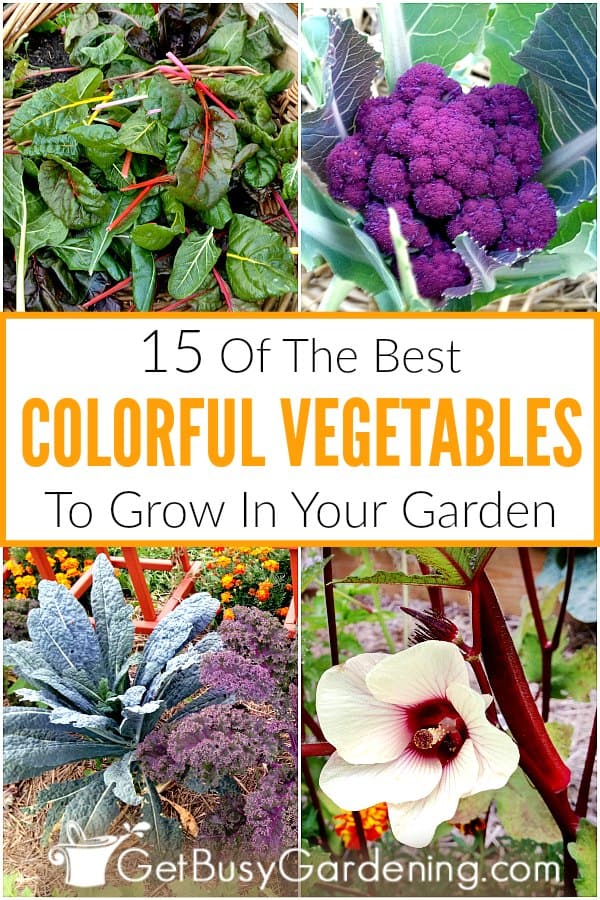



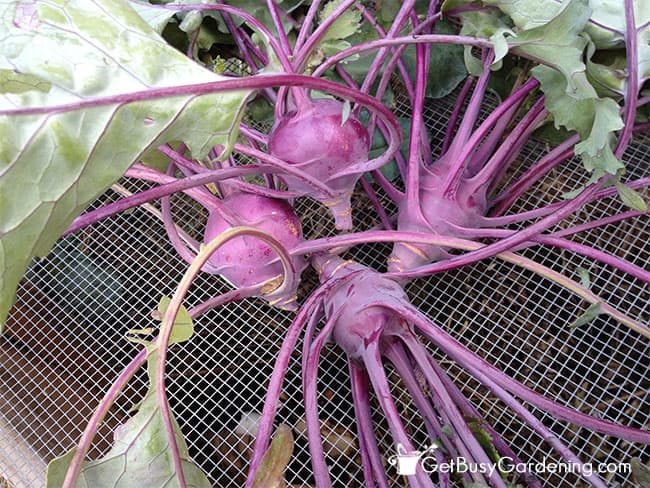



Claudia says
Hi Amy,
I planted 2 “squash” plants and they are taking over my garden and smothering other things. I am trying to train them vertically but it continues to grown along the garden. Is it okay to remove some of the leaves without hurting the plant. I need any HELP you can give.
thanks,
Claudia
Amy Andrychowicz says
Sure, you could remove some of the leaves, but don’t remove too many or it could harm the plant. It might be just as much work to do that as it is to continue to train them to grow vertically. Maybe you need a taller vertical support. Once my squash vines start growing up my squash arch, it’s pretty easy to keep the tame by just tucking in the vines as they grow (I do this a couple times a week or so). Here’s more info… How To Grow Squash Vertically.
Laura says
Well, peppers are my favorite colored veggie. I plant the colored varieties and read many times over to leave them on the plant and they’ll turn into reds, oranges and yellows.
At least that’s what supposed to happen in my perfect world. I end up with green peppers with a few red blotches/streaks. What to do? Do I just leave them up even longer hoping the whole pepper will change color?
Also plant marigolds for color and I’ve also read they help with pest control. And even if they don’t, they add a pop of color. Since I live in the burbs, I need to think about curb appeal so the neighbors don’t get too annoyed over my ever-expanding garden.
Amy Andrychowicz says
Yes, eventually the whole bell pepper will change color and be much sweeter. I guess it depends on how long you want to wait. Our growing season is very short here in Minnesota, so many of our bell peppers are still green by the end of the season. Bell peppers are slow to mature.
Marigolds are great for deterring pests, and also attracting beneficial insects to pollinate and eat the bad bugs. I line my gardens with marigolds every year, they are my favorite vegetable garden flowers!